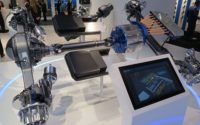Active Grille Shutter Technology: Enhancing Fuel Efficiency in Modern Vehicles
From General Motors to BMW, Honda to Mercedes, Mazda to Roll Royce, auto manufacturers are popping a number of economy and luxury models with automotive active grille shutters to make use of their aerodynamic advantages for improving fuel efficiency. An active grille shutter is designed to reduce the aerodynamic drag of the car, increase the warmup time of the engine, reduce drag at high-speed, and retain engine heat when the vehicle is parked. As manufacturers are focusing on addressing the rising fuel-economy standards and reducing vehicle emissions, the active grille shutter is largely gaining traction. Strict government regulations regarding fuel emissions and increasing global vehicle production are adding to the global active grille shutter market growth. Moreover, increasing research and development activities to develop compact active grille shutters with advanced and lightweight materials are contributing to the market growth. The growing trend of implementing intelligent thermal management and thermoacoustic engine encapsulation is expected to create more demand for active grille shutters in the coming years.
Rising Need for Fuel Efficiency to Boost Active Grille Shutter Demand
The Corporate Average Fuel Economy standards require automakers to hit an average of 49 mpg across their fleet of passenger cars and light trucks by 2026 to cut greenhouse gases, reduce air pollution, and reduce consumption of oil and gas. Hence, manufacturers are already making incremental improvements by incorporating technologies like active grille shutters. The active grille shutters improve fuel economy by 0.5% and save around 3.6 gallons of gas annually for an average driver to improve aerodynamic efficiency. Besides, active grille shutter integration into vehicle help achieve CO2 saving of up to 3 grams per kilometer, which would help reduce carbon emission levels. As governments around the world are focusing on reducing carbon emission levels, manufacturers are expected to integrate active grille shutters in their forthcoming models to comply with the regulations, projected to boost the market growth.
Electric Mobility Leads to Increasing Integration of Active Grille Shutters
Active grille shutters enable automotive manufacturers to achieve nearly 20% weight reduction of a specific vehicle, which is quite important for reducing weight in electric and hybrid vehicles. Less weight of the car reduces the overall energy consumption for acceleration with a 30% improvement in aerodynamic performance. As intelligent mobility and electrification are shaping the future of mobility, several automobile manufacturers prefer to incorporate AGS systems in their electric vehicles. With the growing demand for electric and hybrid vehicles owing to increased environmental consciousness and fluctuating gas prices, AGS integration is expected to increase even further in the coming years.
Since the active grille technology is relatively new, challenges exist to coordinate the shutter shut down time with engine speed as it integrates with the HVAC unit. Besides, the active grille shutter is an expensive aerodynamic feature, which increases the manufacturing cost for automobile manufacturers and owners. Besides, low-segment vehicle manufacturers may opt for diffusers, spoilers, and underbody panels to minimize air drag, which could hamper the growth of the global active grille shutter market in the coming years.
According to TechSci Research report on “Global Active Grille Shutter Market By Shutter Type (Visible Active Grille Shutter & Non Visible Active Grille Shutter), By Vehicle Type (Passenger Vehicle and LCV), By Vanes Type (Horizontal Vanes vs Vertical Vanes), By Region, Competition Forecast & Opportunities, 2027”, the global active grille shutter market is anticipated to grow at a formidable rate during the forecast period. The market growth can be attributed to the increased need for fuel-efficiency in premium vehicles coupled with stringent government regulations to reduce carbon emissions.
Contact
Mr. Ken Mathews
708 Third Avenue,
Manhattan, NY,
New York – 10017
Tel: +1-646-360-1656



